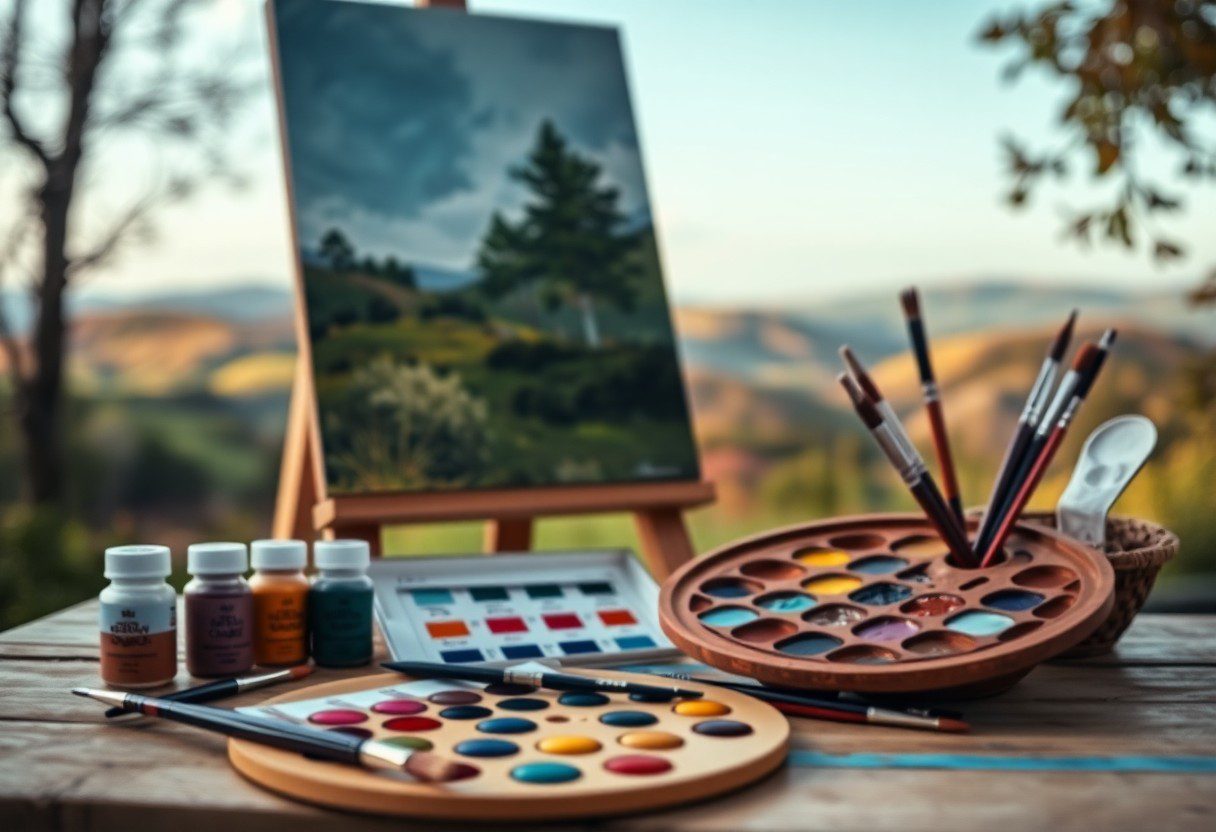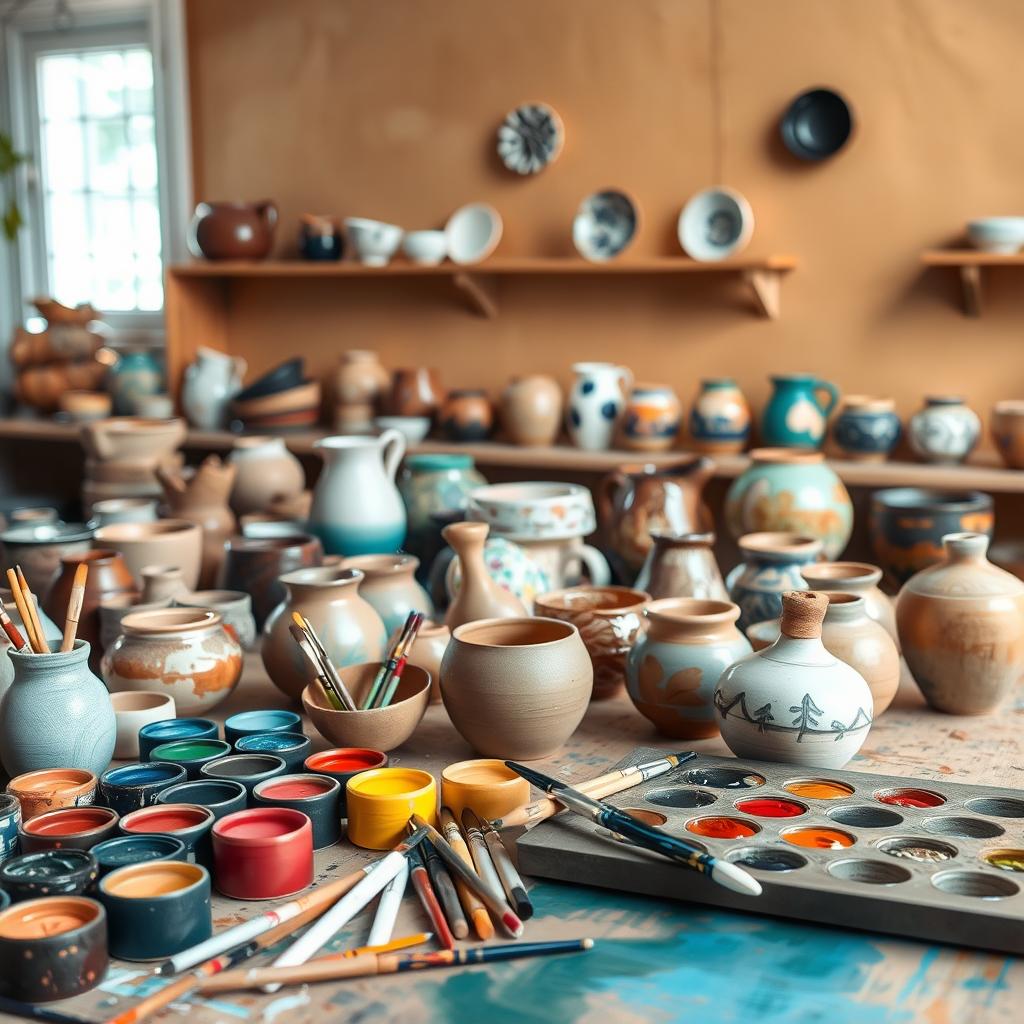There’s a world of creativity waiting for you in landscape painting, and having the right art supplies can make all the difference. Whether you are a budding artist or a seasoned pro, equipping yourself with quality materials will enable you to capture the beauty of nature on your canvas. In this post, you will discover the crucial art supplies that will help elevate your landscape artwork, making it vibrant and striking.
Essential Painting Tools
For captivating landscape paintings, having the right tools is vital. You need to equip yourself with important painting implements that enhance your workflow and creativity, allowing you to bring your artistic vision to life. From brushes to palette knives, each tool serves a unique purpose in the creation of stunning landscapes.
Brushes
Brushes are your primary instruments for applying paint to canvas, and having a variety of them will allow you to experiment with different techniques. Flat, round, and fan brushes each offer unique effects—whether it’s broad strokes for skies or detailed work for foreground elements. Invest in a range of sizes to ensure versatility in your landscapes.
Palette Knives
Around brushes, palette knives are important for adding texture and dimension to your landscapes. They allow you to mix colors and apply paint in a more controlled manner than brushes. With their flexible blade, you can create sharp lines or smooth over areas to blend colors seamlessly.
Further, palette knives are not just for mixing; they can also be used for painting directly onto the canvas. Their ability to create thick, impasto textures can add depth to your artworks, making elements like trees and rocks come alive. Experimenting with a palette knife can open up new avenues for creativity in your landscape paintings.
Paint Types
You should consider various paint types to enhance your landscape paintings, each offering unique benefits and effects. Here’s a breakdown of popular options:
| Type | Description |
| Oil Paint | Rich, vibrant colors with long drying times for blending. |
| Acrylic Paint | Fast-drying and versatile, suitable for different techniques. |
| Watercolor | Transparent and delicate, great for soft landscapes. |
| Pencil Crayon | Allows for detailed line work and easy layering. |
| Pastels | Soft, blendable colors ideal for vibrancy. |
Knowing which type suits your style best will greatly impact your artwork.
Oil Paints
Types of oil paints can range from traditional to modern quick-drying options, allowing you to create depth and luminosity in your landscape paintings. They mix well and provide a rich texture, making them ideal for creating detailed layers and intricate color blends.
Acrylic Paints
Any artist appreciates the versatility of acrylic paints, which dry quickly and can be used in various techniques. Their adaptability allows you to mimic oil painting styles or create watercolor effects, making them perfect for landscapes.
Consequently, acrylics can be thinned with water for washes and used straight from the tube for bold, opaque applications. This adaptability makes them an excellent choice for both beginners and experienced painters, as you can experiment with diverse styles and techniques without lengthy drying times.
Surface Choices
Some artists may overlook the importance of surface selection, but it can dramatically influence your landscape paintings’ final appearance. Different materials respond uniquely to paint, and selecting the right one for your style will enhance your work. Whether you prefer the texture of canvas or the precision of paper, understanding your options will guide you toward creating stunning landscapes.
Canvas
Among the most popular choices for landscape painters, canvas provides a sturdy and versatile surface that is ideal for various painting techniques. It can handle heavy applications of paint, making it suitable for both oil and acrylic mediums. Whether you choose pre-stretched or rolled canvas, ensure it is of high quality to withstand the test of time.
Paper
The right paper can elevate your landscape paintings, providing a unique texture and absorbency that can enhance your work’s detail and color. Various types of paper, such as watercolor or mixed media, offer different finishes to suit your artistic needs.
In addition, investing in high-quality, acid-free paper will help preserve your landscape artworks for years to come. The weight of the paper also matters—heavier options withstand wet mediums better, while lighter sheets are often more suitable for sketches or dry techniques. Experiment with different types to find the one that best captures your artistic vision in landscape painting.
Color Theory Basics
Despite the complexities of art, understanding color theory can significantly enhance your landscape paintings. This foundational knowledge allows you to create mood, depth, and harmony in your artwork. By grasping the relationships between colors, you can make informed choices that elevate your landscapes to stunning works of art.
Understanding Color Mixing
Against the backdrop of color theory, color mixing is an imperative skill every painter should develop. By blending primary colors, you can create a vast array of hues and shades that will enrich your palette. Fostering a keen understanding of warm and cool colors also helps you depict the atmosphere and light in your landscapes.
Choosing a Color Palette
Beside knowing how to mix colors, selecting a color palette is a fundamental step that dictates your painting’s overall feel. A well-chosen palette not only simplifies your decision-making process but also ensures that your work remains cohesive and visually appealing.
Plus, when choosing your color palette, consider the emotional impact of colors and how they interact with one another. Limit your selection to a few harmonious colors that reflect the scene you want to paint. This restraint can lead to a more unified composition and encourages you to explore variations in tone and shade, ultimately enhancing the emotional resonance of your landscape painting.
Additional Supplies
Keep in mind that while your main art supplies are imperative, additional tools can elevate your landscape paintings. Items like masking tape, palettes, and brush cleaners can streamline your process, making it easier to achieve the desired results. So, take the time to consider enhancing your toolkit with these extras for improved efficiency and effectiveness in your painting sessions.
Easels
Below are a few key factors to consider when choosing an easel for landscape painting. Select an easel that suits your style, whether a standing or tabletop model fits your context. Stability is vital, especially when working outdoors where wind may come into play. An adjustable easel will accommodate various canvas sizes and positions for a more comfortable painting experience.
Varnishes and Mediums
On the subject of varnishes and mediums, these products can significantly enhance your artwork by adding depth and richness to your colors. Various mediums can change the consistency of your paints to achieve different effects, while varnishes protect your finished piece and enhance luminosity.
Indeed, understanding varnishes and mediums is imperative for achieving the best possible results with your landscape paintings. Mediums can modify paint texture or drying times, providing you with greater control over your work. Varnishes, on the other hand, serve as a protective layer, safeguarding your artwork from dust and UV rays, which helps maintain vibrancy over time. By incorporating these supplies into your toolkit, you’re setting the stage for stunning results that are both durable and visually appealing.
Helpful Accessories
To elevate your landscape painting experience, incorporating helpful accessories into your toolkit is crucial. From ensuring a clean workspace to maintaining the quality of your materials, these items will enhance your efficiency and creativity during the painting process.
Rags and Paper Towels
Any artist knows that having an ample supply of rags and paper towels on hand is vital. These items come in handy for quickly cleaning brushes, wiping off excess paint, or even mopping up accidental spills. Having them within reach allows you to focus on your art without disruptions.
Water Containers
Beside your paints, a reliable water container is indispensable for any landscape painter. You’ll need a vessel for cleaning brushes and diluting colors, which helps create the desired shades and textures in your work.
At the beginning of your painting session, consider a container that is shallow and wide for easier access to water. It’s beneficial to change the water frequently to maintain the cleanliness of your brushes and avoid muddy colors. Whether you choose a repurposed jar or a dedicated water pot, ensure it’s sturdy enough for outdoor use, especially if you’re painting en plein air.
Final Words
Considering all points, equipping yourself with the important art supplies is the first step toward creating stunning landscape paintings. By investing in high-quality paints, brushes, canvases, and tools tailored to your artistic vision, you can elevate your work and capture the beauty of nature. Take time to explore various mediums and techniques, allowing your unique style to flourish. With the right materials at hand, your creativity can flow freely, resulting in breathtaking landscapes that resonate with your audience.
FAQ
Q: What are the fundamental materials needed for landscape painting?
A: To create stunning landscape paintings, you will need a selection of paints (acrylic, oil, or watercolor), brushes of various sizes, a palette for mixing colors, canvas or watercolor paper, and a sturdy easel. Optionally, a palette knife can be useful for mixing paints and creating texture.
Q: How important is the choice of paint when painting landscapes?
A: The choice of paint plays a significant role in how your landscape painting will turn out. Acrylics dry quickly and are versatile, while oils provide richer colors and are known for their blending capabilities. Watercolors are excellent for capturing light and delicate textures. Selecting the right medium depends on your artistic style and the effects you wish to achieve in your landscapes.
Q: What brushes work best for landscape painting?
A: A range of brushes will benefit landscape painting, including flat brushes for broad strokes, round brushes for details, and fan brushes for textures like foliage. Synthetic brushes can work well with acrylics, while natural bristles often complement oils. A variety of sizes will help you create different effects and levels of detail.
Q: Are there specific colors that are necessary for landscape paintings?
A: Yes, there are several colors that are particularly effective for landscape paintings. A basic palette should include colors like titanium white, burnt sienna, ultramarine blue, cadmium yellow, and phthalo green. These colors can be mixed to create a range of hues found in nature, from rich earth tones to vibrant skies.
Q: What type of surface is best for landscape painting?
A: The best surface for landscape painting depends on your chosen medium. For acrylics, canvases or acrylic paper work well, while oils can be applied on primed canvases or wooden panels. Watercolors should be painted on high-quality watercolor paper, which is designed to absorb water without warping. Experimenting with different surfaces can help you discover what you prefer for your landscape works.





